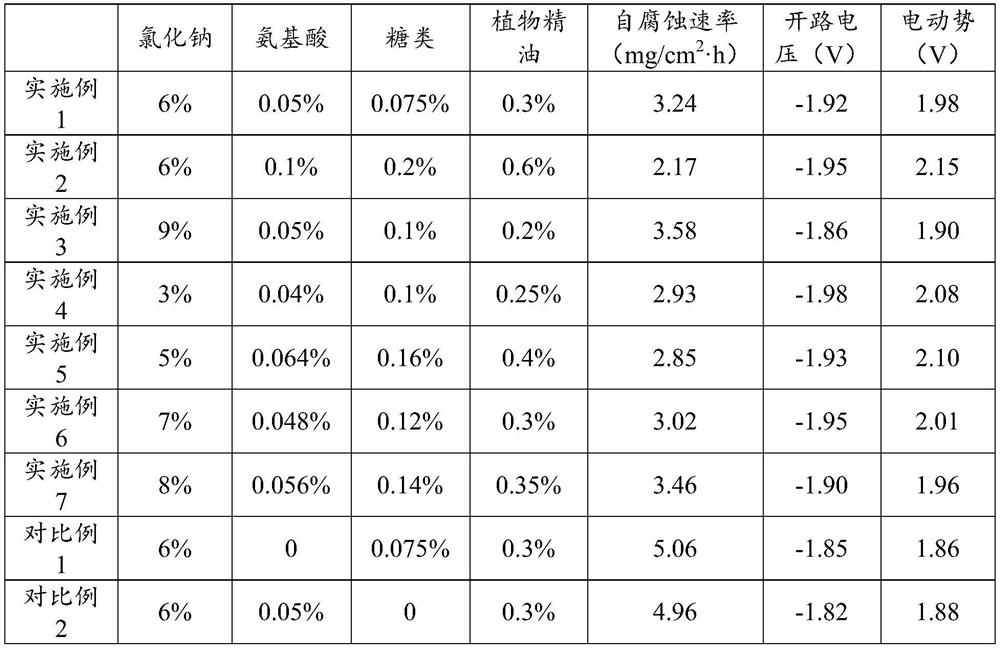Electrolyte and aluminum air battery
An aluminum-air battery and electrolyte technology, applied in the field of electrochemistry, can solve problems such as non-compliance with environmental protection requirements, high production costs, and human poisoning, and achieve excellent electrochemical performance, low self-corrosion rate, and prolong discharge life.
- Summary
- Abstract
- Description
- Claims
- Application Information
AI Technical Summary
Problems solved by technology
Method used
Image
Examples
Embodiment 1
[0044]The electrolyte solution of this embodiment is composed of the following preparation raw materials in mass percentage: 6% sodium chloride, 0.5% corrosion inhibitor and the balance is water. 100g
[0045] The corrosion inhibitor of the present embodiment is made up of the preparation raw materials of following mass fraction: 10% natural amino acid (cysteine), 15% saccharide compound (glucose), 60% plant essential oil (tea tree essential oil, CAS number : 68647-73-4) and the balance is ethanol.
[0046] The preparation method of the electrolytic solution is as follows: adding sodium chloride to water to obtain a sodium chloride solution; then adding a corrosion inhibitor to the sodium chloride solution to obtain the above electrolytic solution.
[0047] The aluminum-air battery of this embodiment includes an aluminum anode, an air cathode, and an electrolyte, and the electrolyte is the above-mentioned electrolyte for the aluminum-air battery.
[0048] The aluminum anode ...
Embodiment 2
[0055] The difference between this embodiment and embodiment 1 is:
[0056] The electrolyte solution of this embodiment is composed of the following preparation raw materials in mass percentage: 6% sodium chloride, 1% corrosion inhibitor and the balance is water.
[0057] The corrosion inhibitor of the present embodiment is made up of the preparation raw materials of following mass fraction: 10% natural amino acid (cystine), 20% carbohydrate compound (maltose), 60% plant essential oil (tea tree essential oil) and balance to ethanol.
[0058] The self-corrosion rate of the aluminum alloy anode of this embodiment in the electrolyte is 2.17 mg / cm 2 h. The open circuit potential is -1.95V (vs. SHE), and the discharge current density of the air battery in the electrolyte is 100mA / cm 2 When testing for 10 hours, the electromotive force is 2.15V, and the surface of the anode alloy is corroded uniformly.
Embodiment 3
[0060] The difference between this embodiment and embodiment 1 is:
[0061] The electrolyte solution of this embodiment is composed of the following preparation raw materials in mass fraction: 9% sodium chloride, 1% corrosion inhibitor and the balance is water.
[0062] The corrosion inhibitor of the present embodiment comprises the preparation raw material of following mass fraction: 5% natural amino acid (cystine), 10% saccharide compound (fructose), 20% plant essential oil (tea tree essential oil) and remainder is ethanol.
[0063] The self-corrosion rate of the aluminum alloy anode of this embodiment in the electrolyte is 3.58 mg / cm 2 h. The open circuit potential is -1.86V (vs. SHE), and the discharge current density of the air battery in the electrolyte is 100mA / cm 2 When testing for 10 hours, the electromotive force is 1.90V, and the surface of the anode alloy is uniformly corroded.
PUM
| Property | Measurement | Unit |
|---|---|---|
| thickness | aaaaa | aaaaa |
| thickness | aaaaa | aaaaa |
| thickness | aaaaa | aaaaa |
Abstract
Description
Claims
Application Information
 Login to View More
Login to View More - R&D
- Intellectual Property
- Life Sciences
- Materials
- Tech Scout
- Unparalleled Data Quality
- Higher Quality Content
- 60% Fewer Hallucinations
Browse by: Latest US Patents, China's latest patents, Technical Efficacy Thesaurus, Application Domain, Technology Topic, Popular Technical Reports.
© 2025 PatSnap. All rights reserved.Legal|Privacy policy|Modern Slavery Act Transparency Statement|Sitemap|About US| Contact US: help@patsnap.com


